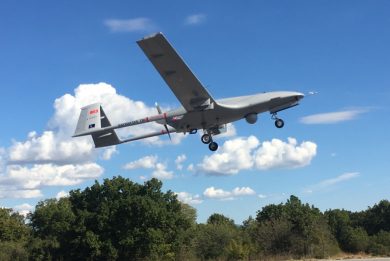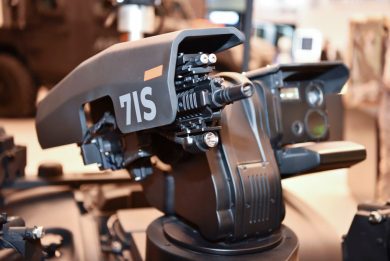IDEX 2025 – EDGE and Flaris unveil the Sinyar LAR3P ISR and combat drone
The story of this UAV started on 10 November 2023, when the EDGE Group announced the acquisition of 50% of the stakes of Flaris, a Polish aviation company specialised in the design and production of personal jets. At the same time, at the Dubai Air Show 2023, the Sinyar LAR1, an ISR (Intelligence, Surveillance and Reconnaissance) unmanned platform was unveiled. At IDEX 2025, unveiling the Sinyar LAR3P, the two companies have gone one step further
Born as a commercial manned aircraft, the Sinyar LAR1 has undergone over 300 flight tests; while the Podgórzyn-based company provided the airframe, EDGE and its companies contributed the autonomy elements and acted as system integrator.
The next step was to develop a drone capable to conduct not only ISAR missions but to carry also ordnance capable to destroy the targets found on the battlefield, reducing at a minimum the sensor-to-shooter loop, a factor that in a rapidly evolving battlefield is becoming more and more critical; the Sinyar LAR3P programme was launched.
“The airframe is made mostly of carbon fibre, which allowed to reduce its empty mass to only 850 kg, maximum take-off mass being 2,200 kg,” Piotr Ładziński, an aerospace engineer engaged in the design new functionalities, told EDR On-Line. Once the fuel tank is filled, 610 kg remain for actual payload. This is installed in the weapon bay, but four more ordnance can be carried under the four pylons, due under each wing.
The aircraft is 8.3 metres long; his mid-wing has a span of 8.7 metres, and terminates with winglets that ensure reduced fuel consumption and higher stability. The tail empennage is made of a horizontal plain and two vertical rudders at the extremities. The fuselage presents the typical forward bump, which among other elements hosts the SATCOM antenna that allows the Sinyar LAR3P to operate at great distances from its home base.
Just behind the wing we find on top of the fuselage the pod containing the Williams FJ5-33A engine, which provides nearly 8.5 kN thrust. “This high thrust to mass ratio allows the aircraft to climb at a 30 m/s rate,” Ładziński explained. This, together with the 650 km/h (350 kts TAS), allows the Sinyar LAR3P to quickly get to the operational area and climb at the right operational altitude; at that point it is possible to reduce thrust and start loitering, looking for targets.
Rapid to deploy by area, the EDGE and Flaris product is also very flexible when deployment by road is needed. “The wings can be easily disassembled, thus the entire aircraft can fit into a container and can be easily transported by a truck,” Piotr Ładziński underlined. The capacity to operate from unpaved runways adds to its flexibility; this is due to the choice of a robust monobloc carriage, the two main landing gears retracting backwards while the nose wheel also rotates forward. The landing gear is high enough to allow the installation of a Wescam MX-15 EO/IR imaging system, which provides the ISR capability.
In clean configuration, therefore without any ordnance underwing pylons, the Sinyar LAR3P endurance reaches 18 hours, the range being 6,000 km, while the maximum altitude is 40,000 ft.
As in the case of the Sinyar LAR1, also the LAR 3 comes from the transformation of a commercial manned aircraft. “The development is currently in the transition phase between manned and unmanned,” Mr. Ładziński explained, “and we are in a phase in which the aircraft flies in an optionally piloted configuration.”
To become a full military aircraft the Sinyar LAR3 must follow a certification process, due to the fact that it was originally certified according to CS-23 specifications. No date was provided on the possible end of that process.
Photos by P. Valpolini







